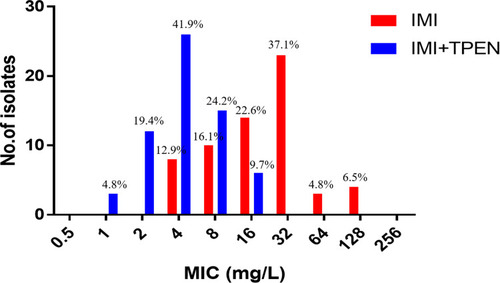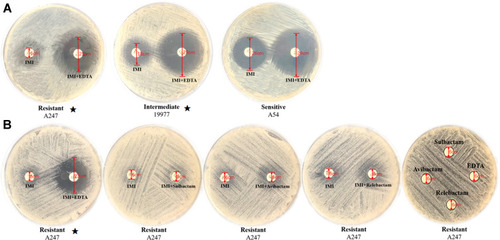Figures & data
Table 1 Imipenem and TPEN Act Synergistically to Inhibit the Growth of Imipenem-Resistant M. abscessus*
Figure 2 Susceptibility of M. abscessus isolates (n=62) to imipenem with or without TPEN. The data above each bar are the percentage of isolates.

Figure 3 Time–kill kinetic assays. In vitro TK assays were conducted with reference strain ATCC19977 (A) and an imipenem-resistant clinical isolate, A189 (B). The bacteria were incubated in the presence of either imipenem or TPEN alone, or in combination at the various concentrations shown. The MIC of imipenem for ATCC19977 and A189 was 16 and 32 mg/L, respectively; the MIC of TPEN was 64 mg/L for both. A bactericidal effect was defined as ≥2 log reduction in CFUs compared to 2×MIC imipenem alone in TK assays. *≥2 log reduction in CFUs.

Table 2 Zone of Inhibition Surrounding Imipenem Disk with or without EDTA*
Figure 4 Detection of metallo-β-lactamases by imipenem-EDTA combined disk method. (A) Zones of growth inhibition are shown surrounding imipenem disks impregnated or not impregnated with EDTA on plates inoculated with imipenem-resistant, -resistance intermediate, or -sensitive M. abscessus strains. EDTA, ethylenediaminetetraacetic acid; IMI, imipenem. (B) The abilities of EDTA, sulbactam, avibactam and relebactam to synergize with imipenem and inhibit the growth of imipenem-resistant (A247) M. abscessus were determined and compared. Imipenem disks were impregnated with or without the compound listed; the surrounding zones of growth inhibition are shown. Bacterial growth surrounding disks impregnated with EDTA, sulbactam, avibactam or relebactam alone (plate on the right) serves as the negative control. ⋆Indicates a zone of growth inhibition ≥5 mm larger than the zone surrounding a disk impregnated with imipenem alone.


